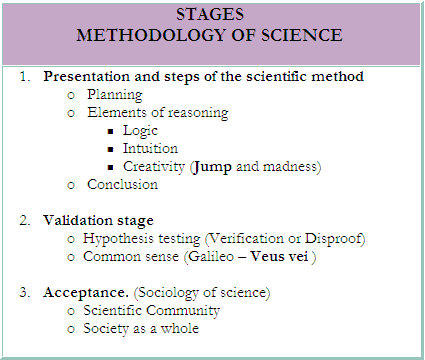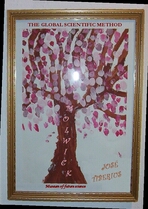2.c) Stages of the scientific method
Presentation, validation and acceptance are the three major stages of the methodology of science.
Within the three basic types of the scientific method (inductive reasoning, deductive reasoning, and hypothesis testing or experimental study), each one has its stages and depends on each author or form of describing and presenting them.
In the previous section were criticisms about some elements in the scientific methodology and the complication its terminology poses for the memory. Now then, when speaking about the steps and stages of the scientific method, something similar occurs: it seems that more than steps of the scientific method, each method has its staircase.
Recognizing the methodology of science is complicated and full of nuances with serious implications, and given the importance of the scientific method, let us present a classification of the stages of the primary scientific methods and their elements to simplify it for non-experts or laypeople.
There is no doubt that this tree of science would have leaves of all shapes and colors. Let us look at some comments and clarifications about this tree.
From this perspective, although the element perception does not work equally in the different proposed methods, nor does it represent an essential difference, it will be in the first step of planning to a greater or lesser extent.
The stages of the methodology of science reflect the importance of the phases through which a theory passes until becoming generally accepted and goes on to make up part of the scientific knowledge.
There is a clear difference in the essence of the experimental study or hypothesis testing and the two other primary methods; therefore, they belong to different stages. Galileo mentioned this division; there are only two methods: deductive reasoning and inductive reasoning, and two processes: the experimental and the rational. We agree with Galileo, although the names could refer to logic and intuition respectively, which is in line with the importance of the different mental elements or processes that support them and the reliability associated with the mentioned processes.
The tree of scientific knowledge would consist of the following:

A new method appears; the creativity uses elements of the intellectual capacities that differ from logic and intuition.
Even a theory based on the deductive reasoning should pass the validation stage since it can be refuted by some logical contradiction on the basis of the planning or an error in the applied logic.
2.c.1. Elements and steps of the scientific method
The intuitive reasoning comes closer to the logical reasoning or logic-deductive reasoning when intuition works with very high reliability; in this case, it would be the equivalent to the classic inductive reasoning. On the contrary, when reliability is lower, it would be more like the experimental study or classic hypothesis testing due to both looking like a trial and error system.
The three steps of the scientific method configuring the first stage of the methodology of science are planning, reasoning, and conclusion, which is common to the three proposed methods. The main difference is the elements of reasoning regarding the type of employed arguments.
Presentation, validation and acceptance are the three major stages of the methodology of science.
The novelty here is the new scientific method Jump or that of creativity, which does not have its base in logic or intuition but rather in the absence of them; or even in deliberately leading them to the contrary. When the intuitive reasoning works with low reliability, it comes close to the Jump method. It is a method that the popular knowledge knows very well, and sums it up in the phrase: think the worst and you won’t be far wrong.
The taxonomies of the second step of the scientific method, the elements of reasoning, are seldom perfect or straightforward because the words tend to have several meanings, and, at times, are too broad or too strict. For example, sometimes, creativity leads to a solid built-in logic, and then it would go outside of the Jump method. Other times, creativity goes far from the logic that becomes madness or deals with an expression of love. Hence, the term Jump method is more appropriate, even though it would be more technical to call it the creativity method.
Sometimes, the method can be accepting something is contrary to what it seems, although almost impossible. Moreover, the argument can repeat. Logically, the reliability of the conclusion will be low, but at times, the result gives an exciting surprise: the conclusion is correct contrary to expectations.
Then, because of the positive verification, a new path to verify the theory with logical or intuitive reasoning is visible. Nevertheless, the relevance of this method has been the first step. The second way was only a tool for articulating the hypothesis testing of the validation stage.
